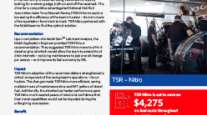Diesel Down 2.5¢ to $3.949; Largest Dip in Five Months
This story appears in the Sept. 30 print edition of Transport Topics.
The average price of a gallon of diesel fuel dipped 2.5 cents to $3.949, the second straight decline and the largest one-week drop in five months, the Department of Energy reported Sept. 23.
Regular gasoline, meanwhile, fell 5.2 cents to $3.495 a gallon, the lowest price since early July, DOE said following its Sept. 23 survey of filling stations.
Diesel’s decline — the biggest since a 3.1-cent drop April 29 — followed the previous week’s 0.7-cent dip. The price was $3.981 in each of the two prior weeks, the highest level since April.
The declines paralleled lower oil prices, which fell to a three-month low below $103 a barrel last week.
“It’s largely on the back of crude oil that’s led to a pullback in diesel prices,” said Addison Armstrong, director of market research at Tradition Energy in Stamford, Conn.
Gasoline has dropped more sharply than diesel because of the seasonal demand decline, Armstrong said.
Diesel is 13.7 cents below the same week last year, and gasoline is 33.1 cents lower, DOE figures showed.
California’s diesel average was the highest in the country last week, topping $4.20 a gallon, according to DOE, but one California-based trucking executive said that even prices in that state were showing signs of slipping.
“We’re seeing some downward movement,” said Jon Richter, who tracks fuel prices for truckload carrier Bear Trucking Inc., based in San Bernardino, Calif.
“A couple of weeks ago, pretty much everywhere it was about $4. Even with our discounted price it was around $4, but now it’s dropped below $4 with our discounts,” Richter said, adding that Bear gets bulk-purchase discounts for the 500,000 gallons of diesel its trucks burn annually.
“Our costs on [Sept.] 6 were just below $4, then it went up to a little over $4. Now it’s down to $3.87,” with the discounted price heading to below $3.80 a gallon, he told Transport Topics on Sept. 24.
Bear Trucking, which primarily carries beverages in Southern California and Phoenix and runs in 11 Western states, has a fleet of 62 trucks.
“Our trucks push 80,000 pounds regularly, and the only place we can save money that trickles to the bottom line is tires and fuel,” Richter said.
“In the last two years, our fleet average age was around [model year] 2010. Since the middle of last year, we’ve added 22 2013s,” he said.
The newer trucks with day cabs have improved fuel economy by as much as 1.5 to 2 mpg, Richter said. “We were in the low 6s [in miles per gallon] and are now getting close to 8,” he said.
The over-the-road trucks are lighter than older models, which also boosts fuel economy, Richter said, though he did not have exact data.
The main driver for upgrading the fleet was the California Air Resources Board’s requirement that fleets have trucks with 2009 engines or newer.
Oil closed at $102.66 a barrel, a 12-week low, on the New York Mercantile Exchange on Sept. 25 on reports of a thaw in U.S.-Iranian relations, Bloomberg News reported. Iran is OPEC’s second-largest oil producer behind Saudi Arabia.
Crude futures topped $110 a barrel in early September, the highest in more than two years, following concerns about potential U.S. military action against Syria, which is near Iran and an ally of that country.
DOE also reported that oil and gasoline supplies rose in the latest week, and although distillate stocks declined, it was less than analysts’ forecasts, Bloomberg reported.
Crude inventories for the week ended Sept. 20 rose by 2.6 million barrels, the first gain in four weeks, rising to 358.3 million barrels from 355.6 million the prior week, which had been an 18-month low.
Gasoline supplies rose by 215,000 barrels, and distillates dipped 235,000 barrels. Bloomberg analysts had predicted downturns in oil and gasoline supplies, and a distillate supply drop of almost 1 million barrels.




